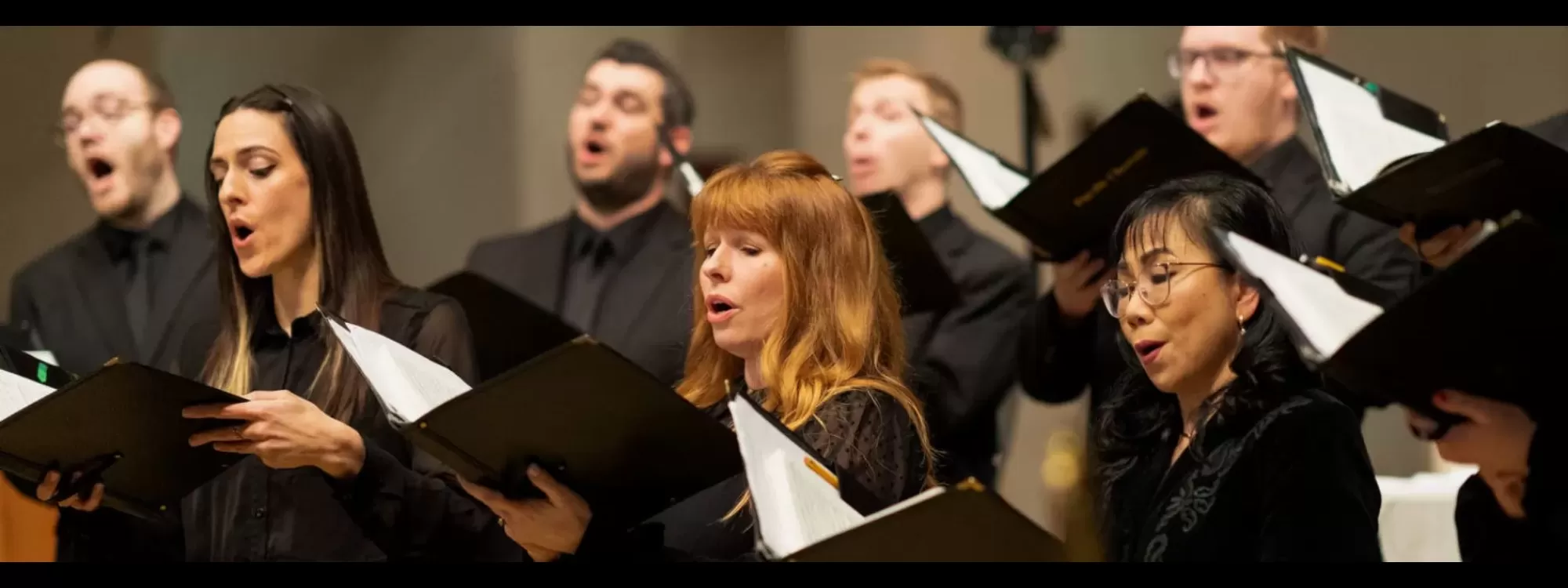- February 13, 2024
Language of Love Program Notes

John Koegel
Professor of Musicology
California State University, Fullerton
Tonight’s Pacific Chorale concert celebrates love in all its complications and complexities. Although the works sung in this performance represent widely ranging musical styles and poetic sources, they all reflect on the different aspects of love: from the discovery of first love, to the joys of committed love, to the heartbreak and loss of love and reconciliation, and finally to enduring, eternal love. The songs are presented in this order to illustrate the progression of the stages of love. Tonight’s concert also functions like a classical song cycle, and although the music of the individual pieces is written in very different musical idioms by different composers, as in a song cycle they are thematically unified in their exploration of the entire range of emotions connected to love.
The poetry that underpins the four classically oriented works composed by Morten Lauridsen, Eric Whitacre, Samuel Barber, and Bob Chilcott is by such luminaries as Rainer Maria Rilke, Federico García Lorca, James Stephens, and Sara Teasdale. The lyrics to the popular songs—written by famous artists such as Cole Porter, Dolly Parton, Edith Piaf, and James Taylor—also demonstrate the changing facets of love. A number of the popular songs sung in choral arrangement tonight are by songwriters of decades past or of the recent past—Porter, Eden Ahbez, Billy Joel, Elton John, and Sting—some of whom are still composing today. Their themes are eternal and their work emblematic of their times; their songs speak to us as vividly today as they did when first written. Adele and Ben Folds— the contemporary singer-songwriters on the program—also address the different aspects of love. Tonight’s concert also features the songs of beloved singers of the past whose memory, voices, and songs are still with us today, especially Nat King Cole and Edith Piaf.
Because of the large number of songs performed tonight, these notes focus on a selection of the most iconic popular songs and the classical pieces, especially as they fit into our song cycle program about the varying phases of love.
The rhyming couplet “The greatest thing you’ll ever learn/Is just to love and be loved in return” in Eden Ahbez’s (George Aberle) famous song “Nature Boy” sets the stage for the lesson of discovering the importance of love. Ahbez’s song was a huge hit in its original 1947 recording by Nat King Cole and in Cole’s frequent live performances thereafter—it was also recorded by many other artists. Ahbez, a free spirit and proto-hippy, dedicated his song to the Nature Boys group of California vegetarian followers of the back-to-nature movement of the 1930s and 1940s. The lyrics and melody transcend that original association and assume a universal theme and appeal.
Eric Whitacre’s lovely a cappella song “With a Lily in Your Hand” from his Three Flower Songs sets the poem “Curva” (Curve) from the Suite de agua (Water Suite) by Federico García Lorca, one of Spain’s greatest poets. Lorca evokes the search for a transcendent, ideal love in the heavenly stars, and the lily is a symbol of desired love: “I leave you with a lily in your hand/Love of my night!/Little widow of my star I have found you.” Whitacre alternates lyrical melodic sections given to the highest voice, with vital, sharp rhythmic interjections by the full choir on the syllable “la” and crunchy dissonances on accented beats.
Cole Porter’s famous “I Love Paris” from his musical Can-Can (1953) represents the realization of the love of place—in this case the French capital. Porter’s song has had a long life separate from its original source and has been interpreted in diverse musical styles by many artists, including Bing Crosby, Etta James, Ella Fitzgerald, and Frank Sinatra. Most singers include the original verse, “Every time I look down on this timeless town/Whether blue or gray be her skies…,” in their performances, although the memorable refrain receives the main emphasis: “I love Paris in the spring time/I love Paris in the fall/I love Paris in the summer when it sizzles/I love Paris in the winter when it drizzles/I love Paris every moment/Every moment of the year.” The first statement of the refrain in the minor key might suggest Paris in winter and the second statement in the parallel major key the city in the spring when it is reborn.
French singer Edith Piaf was known as the “Little Sparrow” because of her diminutive height and aura of fragility. Her famous “La vie en rose” (1946) is one of her signature songs, for which she wrote the lyrics and Louiguy (Louis Guglielmi) composed the music. Piaf sings of the discovery of and reflection upon ordinary-yet-extraordinary love in the words uttered by her lover, and how happiness has entered her heart. The song made a world-wide impact and artists as different as Louis Armstrong, Bing Crosby, Grace Jones, Michael Bublé, Iggy Pop, and Madonna have performed their own memorable versions of the song, although none have superseded Piaf’s rendition.
The longest work on the program and its highpoint is Morten Lauridsen’s frequently performed set of five interrelated songs, the Neo-Romantic Les Chansons des Roses (The Songs of the Roses, 1993), which presents the image of the rose as the figure of a beloved woman. Les Chansons des Roses reflects the great love Lauridsen has for the poetry of German poet Rainer Marie Rilke, who wrote many French poems in addition to much German poetry. The composer creates a grand-scale arch form connecting the five movements, with a recurrence of musical ideas presented in one movement heard in another. The impetus for the composition of the entire set was the composition of “Dirait-on,” which although it was written first is placed last in the group. With its melodic style and repeated refrain, “Dirait, dirait-on,” the song suggests the French chanson populaire repertory performed by Edith Piaf and other French singers. Describing Rilke’s poetry, musicologist Byron Adams quotes William H. Gass, who describes how “roses climb his [Rilke’s] life as if he were their trellis.” Adams also explains how “in his Les chansons des roses, Lauridsen translates the poet’s love for roses into rapturous music that entwines its way throughout the trellis of the listener’s memory.”
The second half of the program opens with Burt Kaempfert and Milt Gabler’s popular light-hearted, swinging song “L-O-V-E” from 1965: “L is for the way you look at me./O is for the only one I see./V is very, very extraordinary./E is even more than anyone that you adore can. […],” made famous by Nat King Cole. It is followed by Sting’s “Fields of Gold” (1993), an introspective song about the beauties of deeply committed, long-term love: “You’ll remember me when the west wind moves/Upon the fields of barley/You’ll forget the sun in his jealous sky/As we walk in fields of gold.”
“The Coolin” from the 1918 collection Reincarnations by Irish poet James Stephens was set by American composer Samuel Barber in 1940 as the last number in his collection of three songs, also called Reincarnations. In his poetry collection Stephens reworked the poems of several early Irish poets writing in Gaelic. According to Stephens: “The word coolin or cooleen refers to a little, very special curl that used to grow exactly in the middle of the back of the neck of a girl. That term, ‘little curl’ or ‘cooleen’ came to mean one’s sweetheart.” The theme of Stephens’s and Barber’s “The Coolin” is not one of young love, but rather of mature love, a love almost extinguished. Stephens “sought to represent that state which is almost entirely a condition of dream wherein the passion of love has almost overreached itself and is sinking into a motionless languor.” Barber was an expert at providing sensitive musical settings to poetry, and he commented on his method: “[When] I am writing music for words, then I immerse myself in those words, and I let the music flow out of them.” We hear this sensitivity to poetic imagery in his beautiful musical setting of Stephens’s “The Coolin.”
So many current and recent popular songs examine the complexities of love and its various stages. The love songs of singer-songwriters Billy Joel, Ben Folds, Adele, and Dolly Parton reach large audiences and four of their songs stand out in particular. The lyrics to Joel’s 1983 hymn-like “And So It Goes” are comprised of eight-syllable lines in iambic tetrameter (short-long, short-long, short-long, short-long): “In every heart there is a room/A sanctuary safe and strong/To heal the wounds from lovers past/Until a new one comes along.” In composing “And So It Goes,” Joel was said to have been influenced by the old British traditional ballad “Barbara Allen,” collected by folklorist Francis James Child. His song is also strongly reminiscent in poetic meter and melodic shape of English composer Hubert Parry’s famous hymn setting “Jerusalem,” with words by poet William Blake, which is also in eight-syllable iambic tetrameter: “And did those feet in ancient time/Walk upon England’s mountains green/And was the holy Lamb of God/On England’s pleasant pastures seen.
Folds’s “The Luckiest” from 2000, Adele’s “When We Were Young” from 2015, and Dolly Parton’s “I Will Always Love You” from 1973 all address different stages of love. Folds emphasizes how lucky one is to have a deep love, even if words cannot adequately express the depth of that love. Adele’s song of remembrance tinged with loneliness also expresses a fear of aging and remarks at the quick passage of time suggested in the song’s title. Dolly Parton’s early ballad “I Will Always Love You” bids farewell to a loved one and emphasizes that the joys and pains of love will remain even after their departure.
The penultimate work on the program, Give Me Your Stars to Hold, is Bob Chilcott’s gorgeous, sensitive setting of Sara Teasdale’s poem “Peace.” Chilcott’s music and Teasdale’s poetry both emphasize a mature, fulfilled love, burnished by the passage of time: “My hopes were heaven-high,/They are all fulfilled in you./I am the pool of gold/When sunset burns and dies,—/You are my deepening skies,/Give me your stars to hold.” Chilcott’s reflective, sensitive musical setting leads directly into the rousing program finale, the well-known song “Come What May” from director Baz Luhrmann’s 2001 film Moulin Rouge!, starring Nicole Kidman and Ewan McGregor: “Come what may […] I love you until the end of time.” The program thus ends on an emphatic note stressing the strength of an eternal love, bringing our concert and song cycle full circle from the exploratory discovery of the possibilities of love through to the state of enduring, mature love.
Learn More about Language of Love on February 24, 2024 here.

